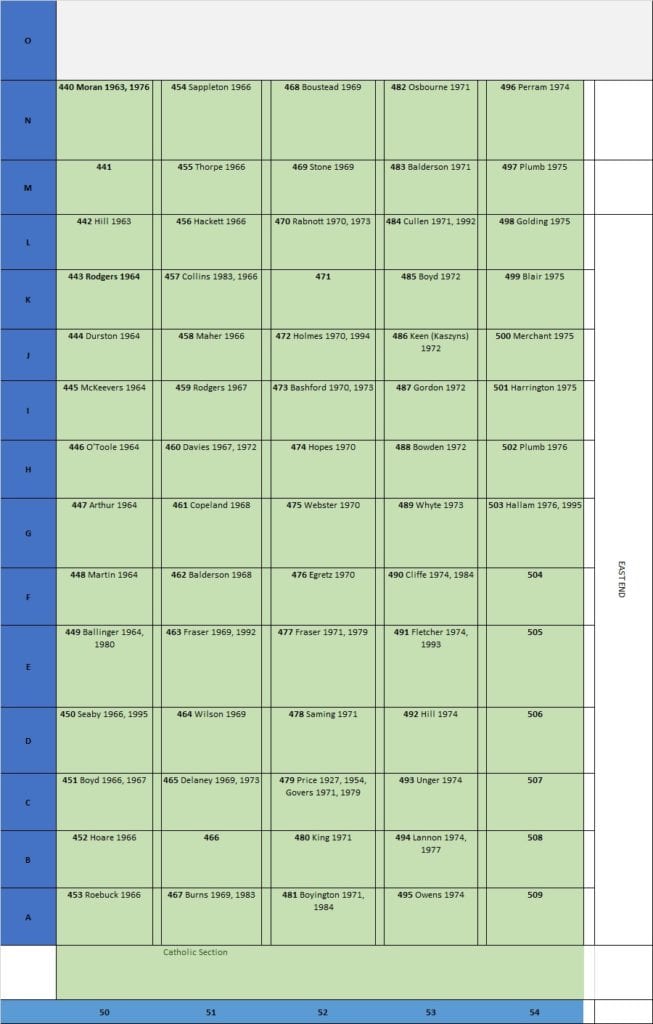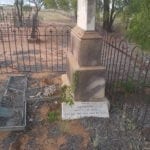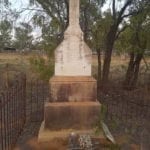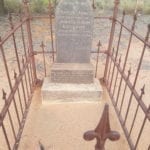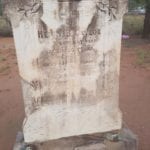THE CEMETERY PLAN
My initial analysis of the 1889-1996 data from the (second) Barcaldine Cemetery has allowed me to construct a series of plan segments to show who’s buried in most of the graves.
Sadly, with the passage of time, most of the earliest graves have no surviving markers or plot outlines such as fences or headstones.
Happily, it is still possible, using a copy of the original plan (kindly supplied by Barcaldine Regional Council) as a reference to map out the grave positions.
Using a summary of the original register printed in 1996 I constructed a new plan and added the surnames of those buried in each plot and their date of burial.
As I mentioned in a previous post, the new Barcaldine Cemetery was surveyed in 1893, but burials had been occurring on the site from 1889.
The first graves appear to have been dug in a rough line along the western fence from the southern side. The first two rows on the plan are evidently not in straight lines. Thereafter, though, the new plan was adhered to.
From the positioning of head stones on the earliest graves, the Barcaldine cemetery appears to have always followed the traditional Christian method of burial – the head at the western end of the grave. This practice mirrored the layout of churches. The dead could then view the coming of Christ on Judgement Day.


[It is possible that each of the plan segments / cross-sections could be printed and laid out next to each other to become one large plan – see below where sections are filled in with names].
Colour Key to Sections
Earliest Graves
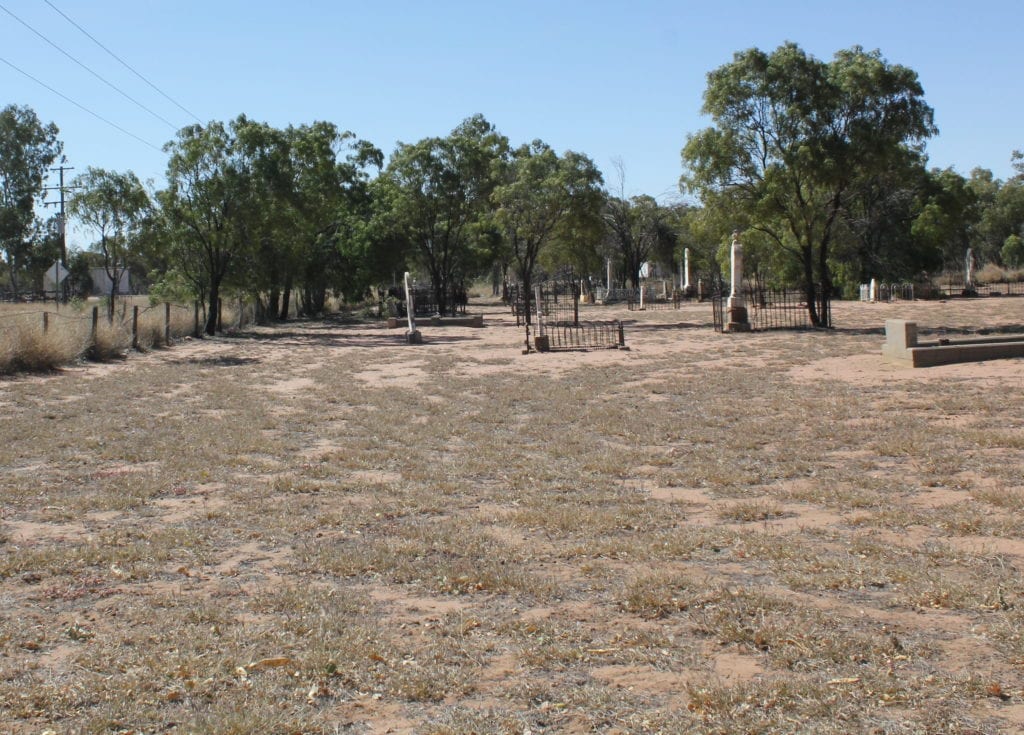
Non-Catholic / Protestant
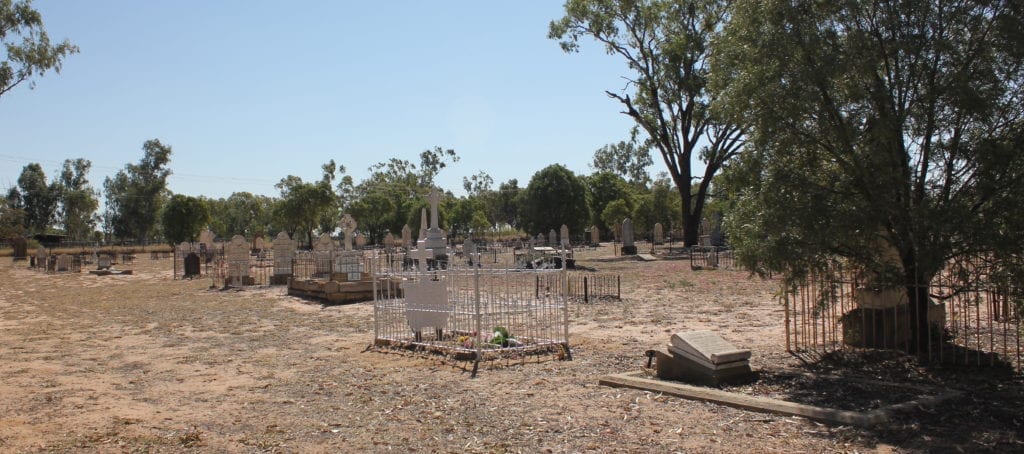
Roman Catholic
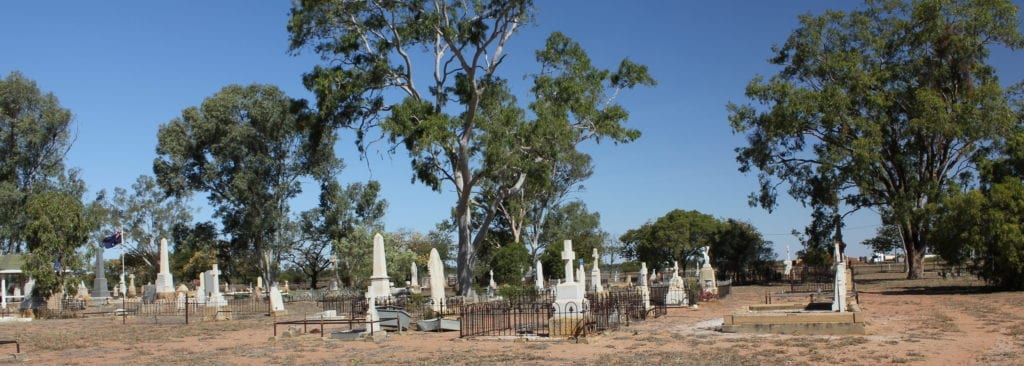
RSL

Please be aware:
- the earliest burial plots in the first two rows were not in straight lines
- the numbers were not sequenced
- some numbered rows are actually pathways in the original plan (no burial plots), which I have shaded light blue/mauve
- numbering for Protestant and Roman Catholic sections do not align.
The map segments read from bottom to top (following the direction of the original 1893 plan). I have added A-AE on the left hand side to make it easier to follow the rows. The plot numbers were sequenced from the south to north for each row in the original plan so I have continued that pattern.
Refer to the plan above to get your bearings.
Remember, some of the earlier gravesites had more than one interment, sometimes up to seven.
DISCLAIMER: I have found that the printed register may not be completely accurate, so my plan may have some discrepancies. For example, the spelling of some surnames in the register do not match with the headstone information.
I intend to amend any errors as they become known to me either through my own research or as people advise me. There is therefore a disclaimer about the accuracy of the maps presented.
Please leave me a comment (at the bottom of this post) if you can correct or add to the information I have presented.
THE EARLIEST GRAVE SITES - first two rows
From the register, the first person buried officially in the new cemetery was an Ah Foo – interred in grave # 29 on 14 May 1889. Three more bodies were buried in #29 between 1892 and 1912.
Grave #1 wasn’t used until almost one year later on 8 April 1890 – another Chinese resident, Ah Kee, the 28th burial in the new cemetery. Again, there were three more bodies buried in that particular grave – between 1891 and 1910.


Cross-section 1 - rows 3-7 in Protestant section
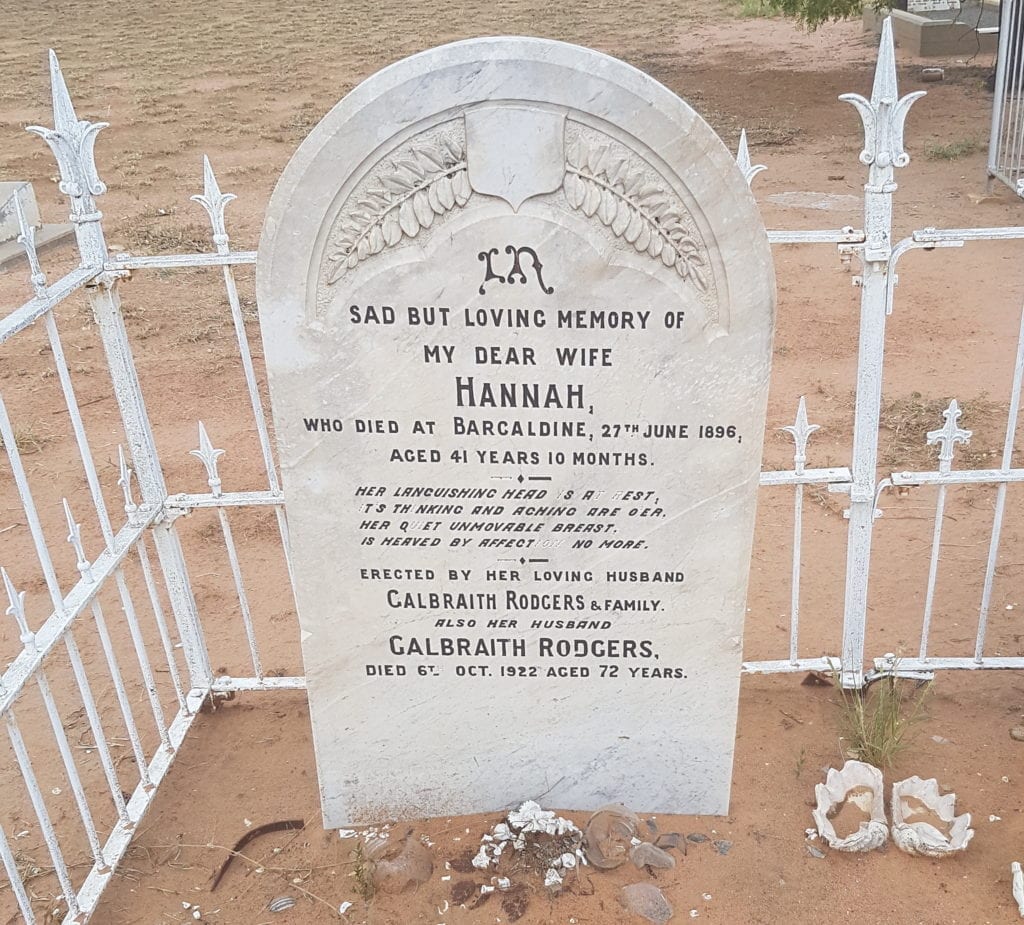
The first person to be entered in the register as a Protestant burial was Hannah Rodgers. Hannah was my great-great grandmother who died in 1896 aged 41 – just a few days after the birth of her 11th child.

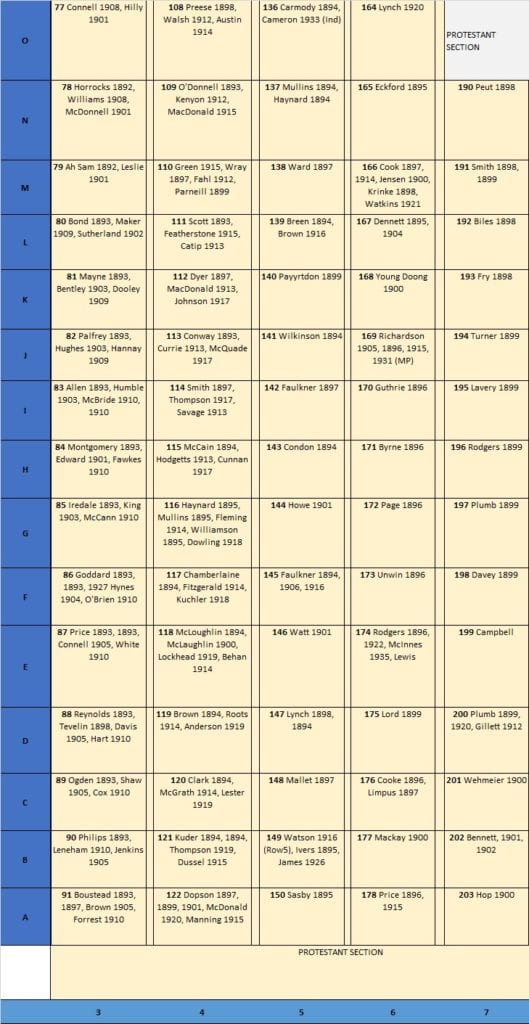
Cross-section 2 - rows 8-12 Protestant section
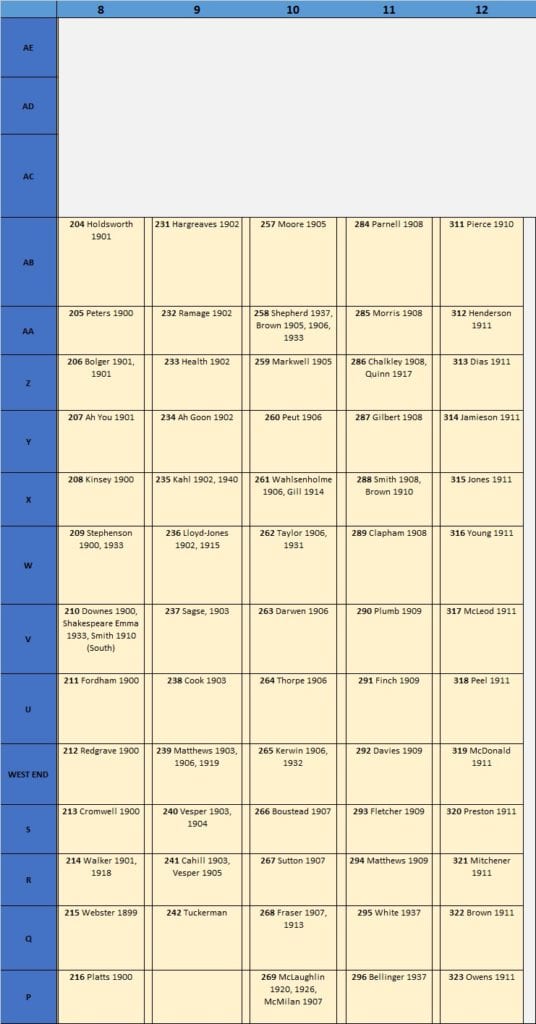
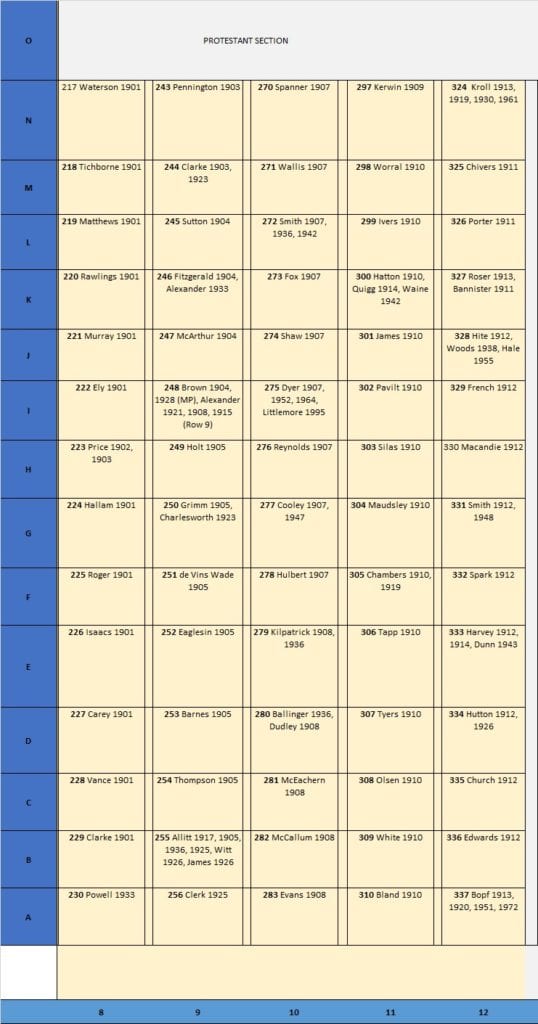
Cross-section 3 - rows 14-18 Protestant section
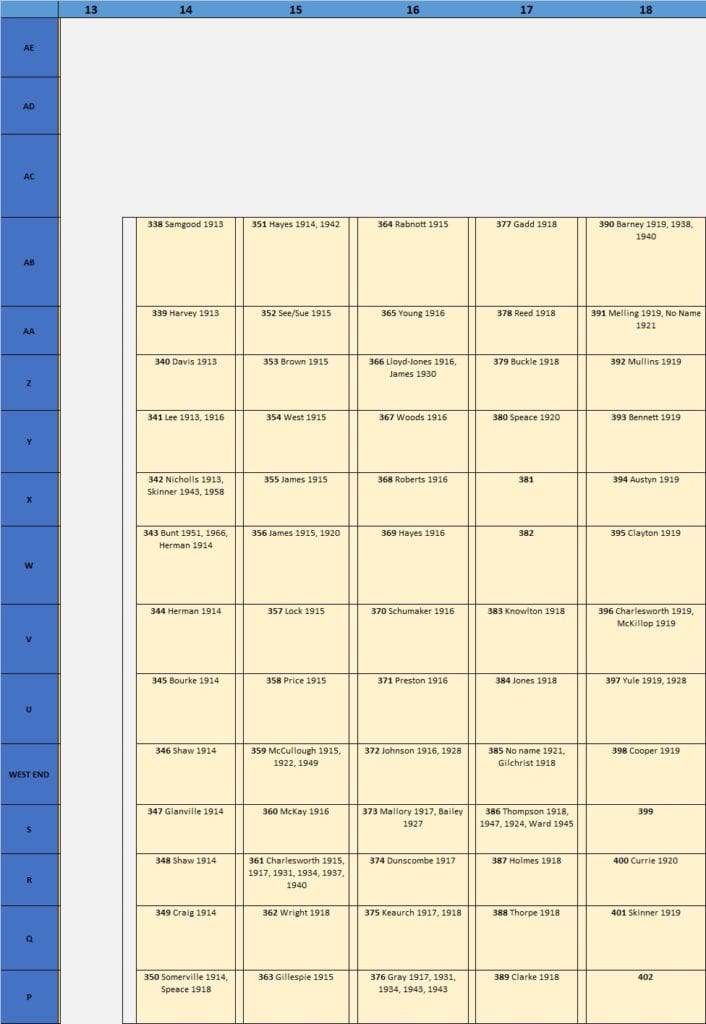
Cross-section 3 - rows 14-18 Roman Catholic section
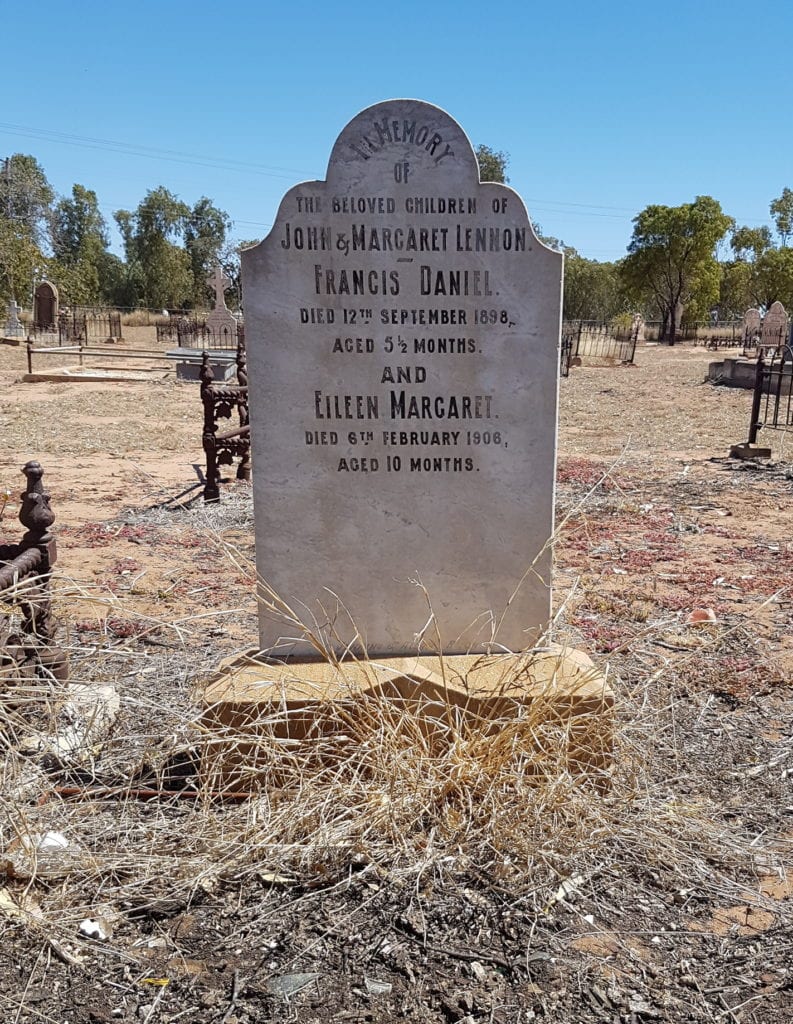
The first person registered in the Roman Catholic section was Francis Daniel Lennon in grave # 22 on 13 September 1898 – aged 5 months 2 weeks.
Sadly, his 10 month old sister was also buried there in 1906.
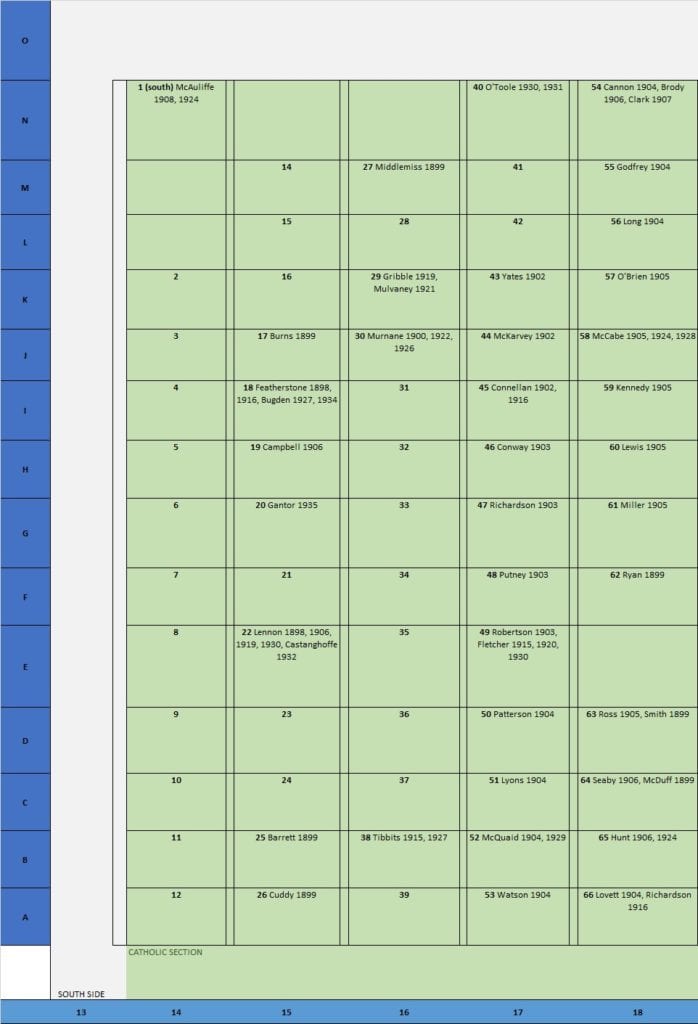
Cross-section 4 - rows 19-23 Protestant section
I’m not sure about at least two sites in this cross-section. It is possible that the names (in red) for grave # 404 [19-AA] should be registered as RC and in the RC section. Grave #95 [21-N] was also registered as ‘2nd’ (not sure what that means).
Also, the placement of #75 [19-F] and #79 [19-B] in the RC section – I’m not sure of the location because they were also registered as ‘South’.
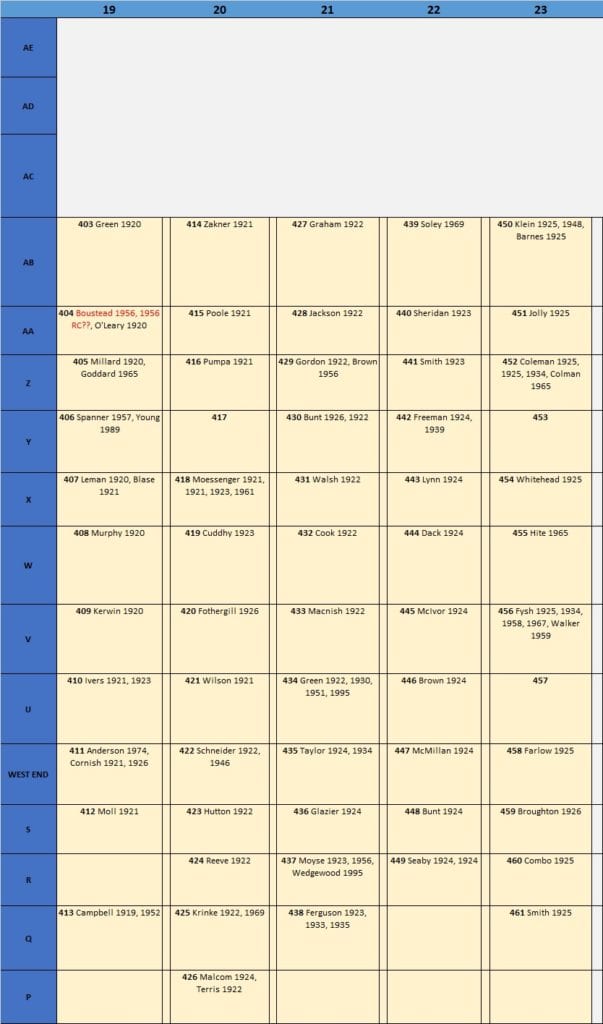
Cross-section 4 - rows 19-21 Roman Catholic section and RSL section

RSL Section
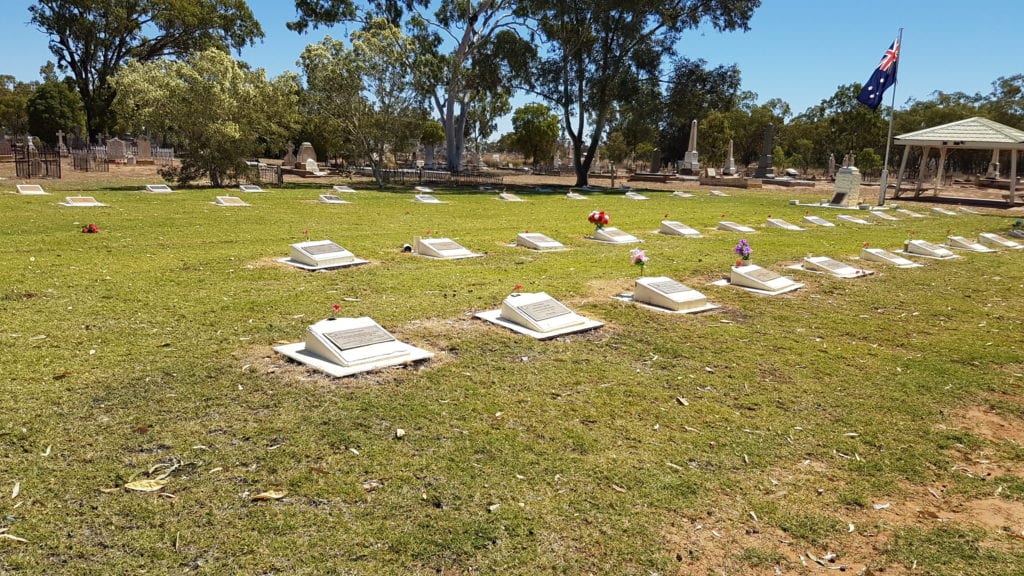
There are no grave numbers recorded for those buried in the RSL section in the summary register so I have drawn up the following list from the information available at this time. The first burial in the RSL section was in 1967.
| 1967 Murphy |
| 1971 Kelly |
| 1971 Hite |
| 1975 Bryant |
| 1976 Reed |
| 1977 Eylander |
| 1977 Stonehouse |
| 1978 Hite |
| 1978 McQuaid |
| 1978 Benton |
| 1979 Lathum |
| 1980 McInnes |
| 1980 Lunn |
| 1980 Anderson |
| 1980 Wason |
| 1981 Kelly |
| 1981 Mansfield |
| 1981 McCallum |
| 1981 Woods |
| 1981 Frazer |
| 1982 Warner |
| 1982 Robertson |
| 1983 Moyse |
| 1983 Gribble |
| 1983 Brown |
| 1984 Robinson |
| 1985 Williams |
| 1985 Beer |
| 1985 Woods |
| 1988 Elliot |
| 1988 Osdalen |
| 1991 Plumb |
| 1991 Rodgers |
| 1994 Scott |
| 1994 Austin |
| 1994 Wicks |
| 1995 Oakley |
| 1995 Mathews |
Cross-section 5 - rows 24-28 Protestant section, RSL section and Roman Catholic section

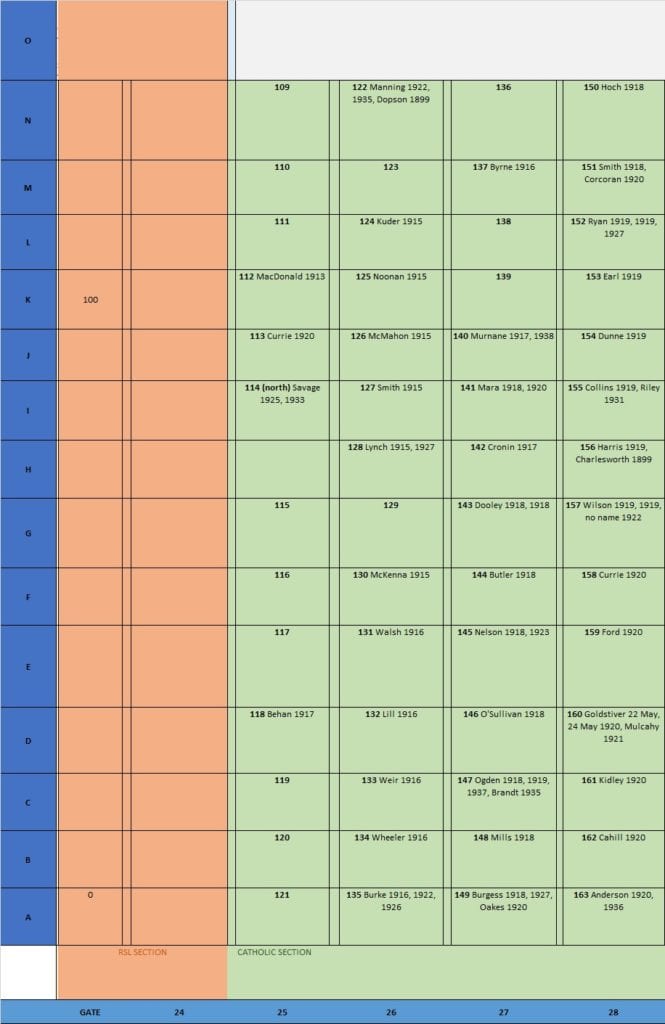
Cross-section 6 - rows 29-33 Protestant section
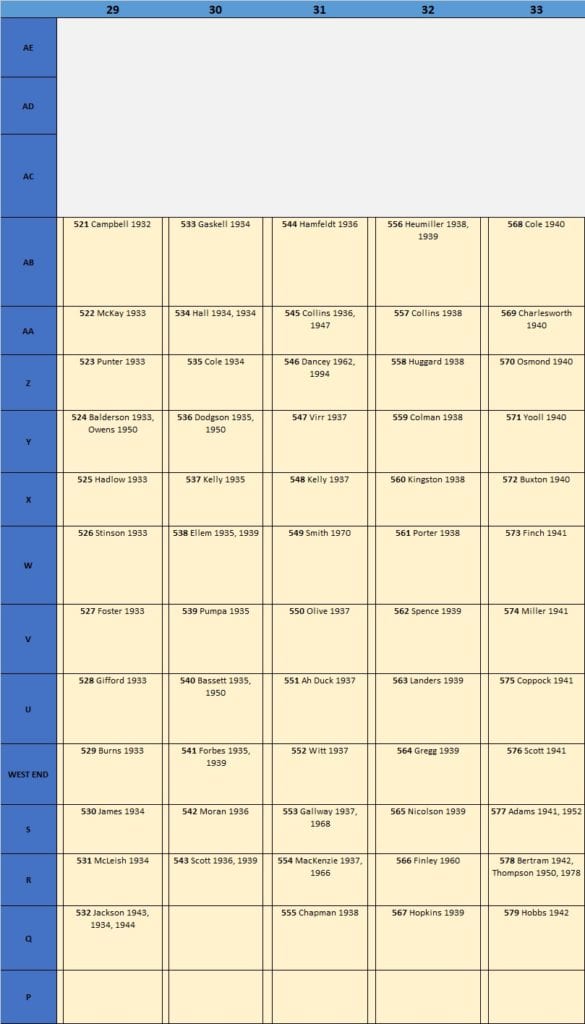
Cross-section 6 - rows 29-33 Roman Catholic section
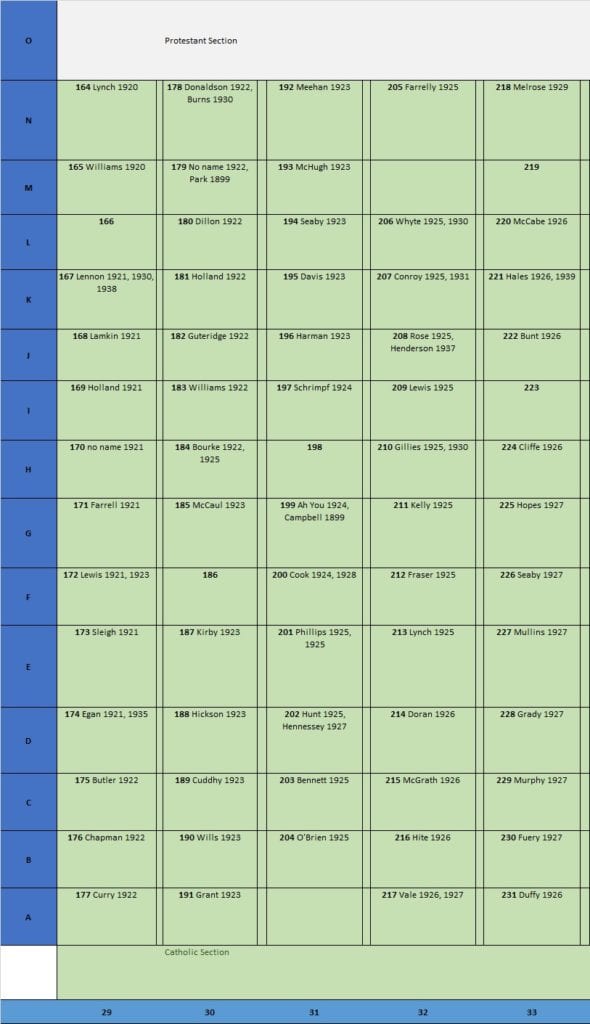
Cross-section 7 - rows 34-38 Protestant, Pauper?, Catholic sections
As I mentioned in my previous post, I am not sure if or where a pauper section might be situated.
There is currently a large area in the cemetery which is just sand on the northern-mid portion where it appears no graves are situated.
There is also a section of numbered plots (see shaded orange on cross-section 7) with no recorded names but there is numbering on the original surveyed plan leading me to suspect it may be the pauper section.
I am continuing to investigate whether some of the graves that have more than one family buried in them – in the Protestant and Roman Catholic sections – may actually not contain all of those I have included. The same numbering may indicate a pauper grave. If I am right about the pauper section (see shaded orange section below) then it is possible that, for example, a pauper is buried in grave # 4 in the orange section, not in the Protestant or Catholic section.
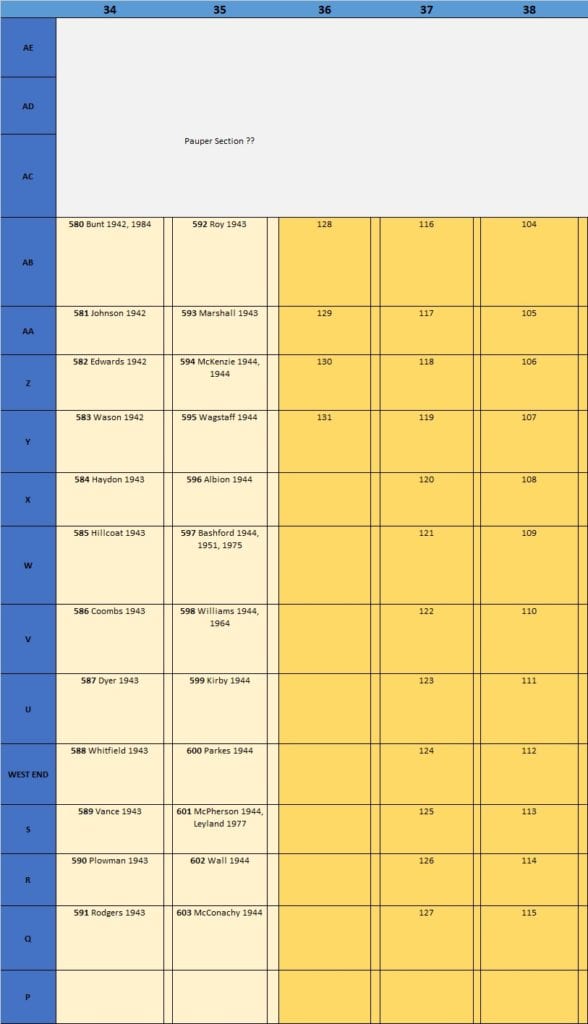
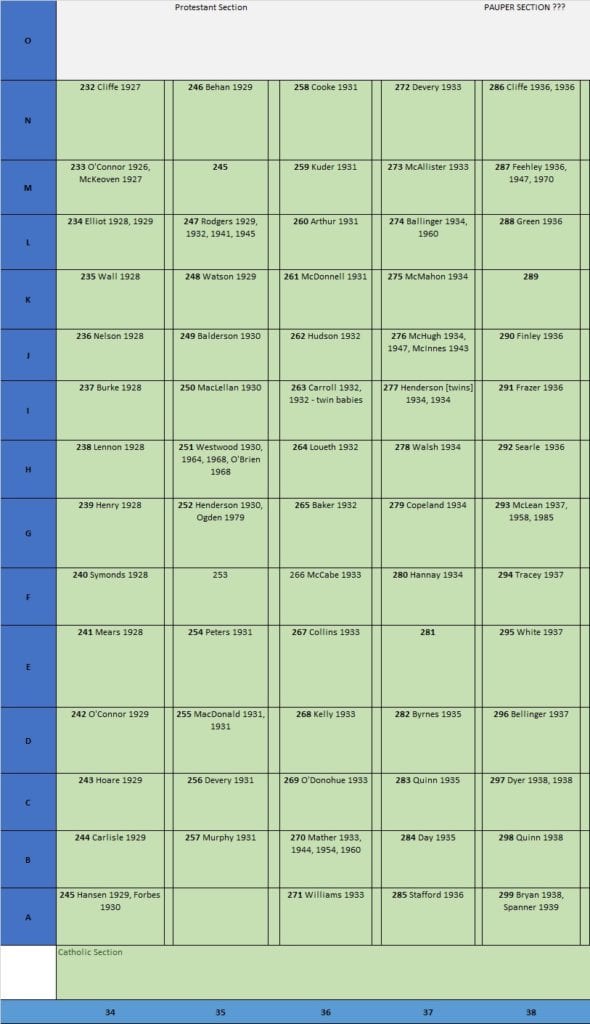
Cross-section 8 - rows 39-43 Pauper section?, Roman Catholic section
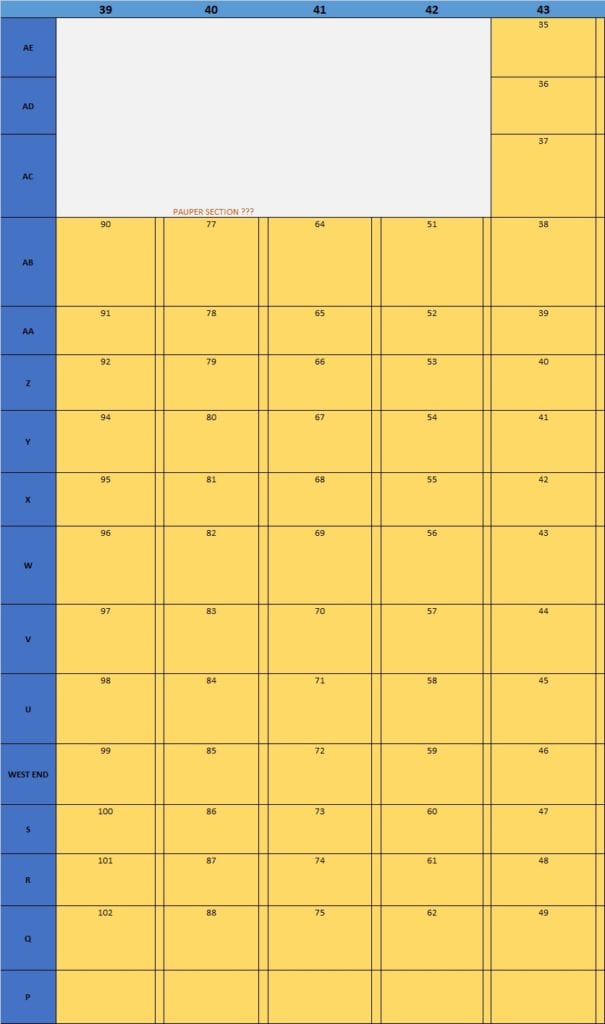

Cross-section 9 - rows 44-49 Pauper section?, Catholic section

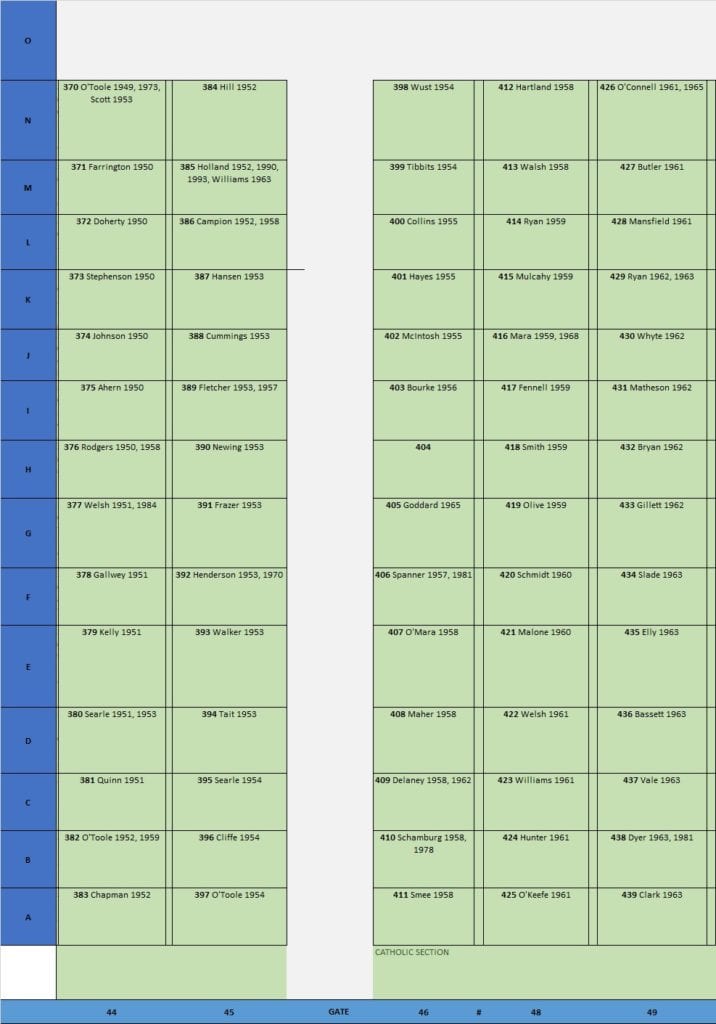
Cross-section 10 - rows 50-54 Catholic section

